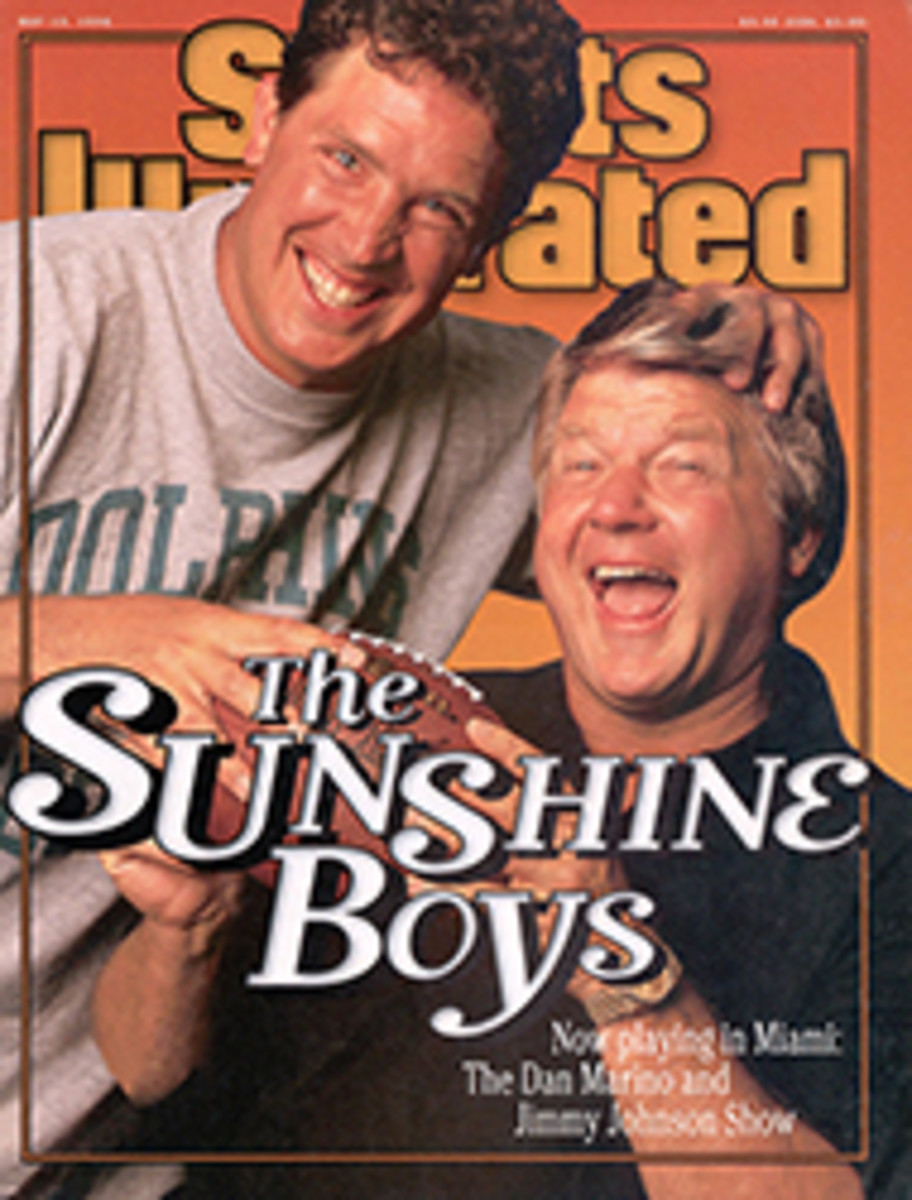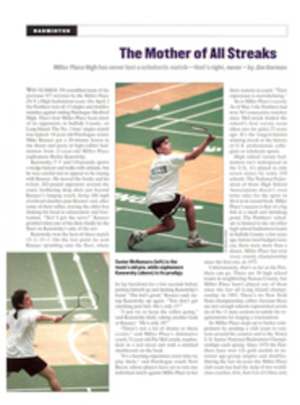
THE ORIOLES' ANDERSON IS HOMERING AT A RECORD PACE UNEXPECTED COMEBACKS OF ELSTER, GUZMAN AND DAVIS
BRADY'S BIG BINGE
A few hours before last Saturday's game in Baltimore, several
Brewers scoured the Orioles' bat rack looking for Brady
Anderson's 34 1/2-inch, 33-ounce Louisville Sluggers. They
wanted to see if Anderson, the major league home run leader, was
putting cork in his bats. Their search came up empty, of course,
because "I hid the corked ones in the corking room," Anderson
said with a laugh.
In the first inning that day, Anderson homered again, for his
15th home run of the season and his sixth leading off a game for
the Orioles. According to David Vincent, co-editor of The Home
Run Encyclopedia, Anderson became the first player to hit as
many as 15 homers by May 4. (The previous best was 13 by Mark
McGwire in 1992.) The home run tear was unlike any Anderson had
ever had, even as a kid. "I didn't hit any homers in Little
League," he says, "so it was actually nothing like this."
Only seven players have hit more leadoff homers in a season than
Anderson hit in the first five weeks (Bobby Bonds holds the
single-season record, with 11 in 1973). Yet this power surge
isn't a total surprise. People who haven't seen Anderson up
close think he's a little guy, but he's 6'1" and 195 pounds. "An
out-of-town reporter said to me the other day, 'Wow, your
shoulders have gotten big. You look strong,'" says Anderson. "I
told him I've looked this way for eight years."
Because of his propensity for strikeouts (slightly more than 95
a year over the last four years), Anderson doesn't seem like a
natural leadoff man. When manager Davey Johnson took over the
Orioles in October, in fact, he said as much, but he changed his
mind after studying Anderson's numbers. Compare Anderson's stats
for the last four years to those of Atlanta's Marquis Grissom,
who is considered one of the best leadoff men in the National
League. Anderson had a higher on-base percentage (.367 to .333)
and scored almost as many runs (373 to 379). "What amazes me is
that last year I scored 108 runs in 143 games, and people still
wondered if I should be a leadoff man," he says.
Always popular in Baltimore--especially with women--Anderson has
become even more of a hero and heartthrob with his
record-breaking binge. Asked whether people on the street are
now calling him Babe, he said with a smile, "Yes, but those
people don't know anything about my home runs."
MANY HAPPY RETURNS
The season is young, but already there are three stirring
comeback stories.
--Rangers shortstop Kevin Elster, 31, last played anything close
to a full season in the majors in 1991, with the Mets. He played
just six games at the start of the '92 season before his right
shoulder, which had been surgically repaired in September 1990,
sidelined him again. After more surgery and rehab, he bounced
around the minors for most of the next three seasons. In 1994
and '95 he made brief appearances with the Yankees before ending
up with the Phillies, and he hit only .186, with one homer and
nine RBIs.
In the first month of this season Elster was the American
League's best shortstop. He showed the same sure hands that Mets
fans saw from 1986 to '92--and much stronger punch at the plate,
which he credits to two years of weightlifting while
rehabilitating his shoulder. At week's end he was hitting .262,
with seven home runs and 25 RBIs.
During his absence from the majors Elster had what he calls "the
greatest experience of my life," when he portrayed shortstop Pat
Corning in the 1994 baseball movie Little Big League. He got the
part when a friend who was a talent agent asked him to read for
it. Elster, who also served as a technical adviser, did so well
that, he says, "they even added some scenes for me."
He has since been offered two other roles, but he declined both
to take a last shot at baseball. Texas general manager Doug
Melvin invited Elster to camp this spring as a nonroster player,
then saw Elster show up overweight. "It wasn't a good first
impression," says Rangers manager Johnny Oates. But a back
injury to shortstop Benji Gil in spring training thrust Elster
into the starting lineup. Now Texas will face a tough decision
when Gil, who's due back on June 1, returns. Elster isn't
worried. "I'll enjoy this as long as it lasts, but I don't want
to play baseball the rest of my life," he says.
--Blue Jays righthander Juan Guzman, 29, has gone from terrific
to terrible and back to terrific. Guzman was 40-11 with a 3.28
earned run average in his first three seasons, from 1991 to '93,
but during the last two he went 16-25, and his ERA climbed to
5.99. He was especially dreadful last year, going 4-14 with a
6.32 ERA.
This year Guzman's nasty slider has been diving again, and his
control--which was horrendous last year--has been sharp. He was
4-1 with a 2.12 ERA at week's end, and opposing batters were
hitting .183 against him, a league low among American League
starters. "He looks like the Guzman of 1992," says Brewers
second baseman-centerfielder Pat Listach. "I think he throws
harder than [Boston's Roger] Clemens. He's throwing 92 [mph] on
the black."
Guzman credits his turnaround mostly to a healthy right
shoulder, which he says he didn't have the last two years. "I
couldn't do what I wanted to do," says Guzman. "It was like
wanting to run but not being able to." Toronto manager Cito
Gaston says that Guzman's shoulder was indeed sore but also
concedes that part of Guzman's problem was his approach.
"Pitchers watch that guy in Atlanta, Greg Maddux, and want to
emulate him, and that isn't good for everyone," says Gaston. "I
think that's what Juan did the last two years. He just wanted to
paint the black. Juan is at his best when he's a thrower, not a
pitcher."
--Reds centerfielder Eric Davis, 33, retired after the 1994
season, saying he had no intention of playing again. He says he
was "mentally exhausted" from trying to overcome his many
ailments, from knee injuries to a lacerated right kidney
suffered when trying to make a diving catch in Game 4 of the
1990 World Series against Oakland, to the last straw, a
herniated disk in his neck. "Starting with the second game of
the '94 season, I took eight shots in my neck in three months,
and the needle was this long," he says, spreading his hands at
least a foot apart.
Davis stayed away from baseball entirely until Cincinnati
shortstop Barry Larkin and utilityman Lenny Harris called him
and asked him to come to one of the Reds' playoff games last
October in Davis's hometown, Los Angeles. He stayed only three
innings. "I couldn't watch the game, knowing that I could still
be doing what they were doing," he says. "But that's when the
adrenaline started flowing again." He spoke with Reds owner
Marge Schott and general manager Jim Bowden that day about
coming back and arrived at spring training with the goal of
simply making the team.
He has done more than that. He won the starting centerfielder's
job and was leading the Reds in home runs (six) and RBIs (23)
after hitting grand slams in two consecutive wins over the
Giants on Saturday and Sunday. He's thankful to be back in the
majors after going more than a year without touching a bat or a
ball. "If you take a year off from basketball, you can go out
and shoot and scrimmage," he says. "There's no way to simulate
major league baseball."
SHORT HOPS
When the Braves' Greg Maddux gave up six earned runs in 8 1/3
innings against the Phillies last Friday, it was the first time
since June 26, 1991, that Maddux had allowed that many earned
runs in a game. He also gave up his first grand slam, to
Philadelphia catcher Benito Santiago, in the ninth inning. It
was the first time in Maddux's 11-year career that he lost a
game in which his team was leading going into the ninth....The
Padres' Tony Gwynn did something rare for him: He struck out
twice in a game on April 28, against the Astros' Darryl Kile. It
was the first time Gwynn had struck out twice in the same game
against the same pitcher since Kevin Gross got him on June 11,
1993.
COLOR PHOTO: ROBERTO BOREA/AP Anderson's first 15 dingers included six while leading off. [Brady Anderson]
COLOR PHOTO: ERIC GAY/AP [See caption above--Brady Anderson]
COLOR PHOTO: JOE GIZA/REUTER [See caption above--Brady Anderson]

